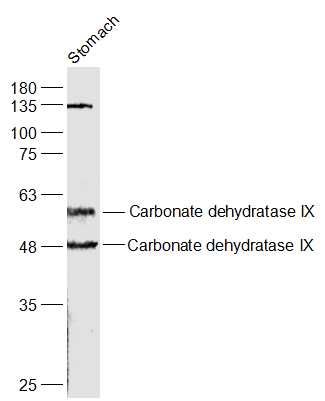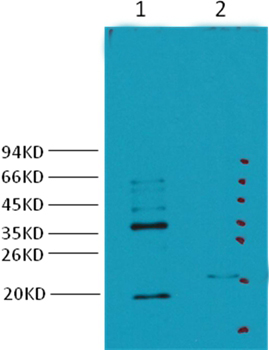Carbonic Anhydrase IX antibody
GTX128428
ApplicationsImmunoFluorescence, Western Blot, ImmunoCytoChemistry, ImmunoHistoChemistry, ImmunoHistoChemistry Frozen, ImmunoHistoChemistry Paraffin
Product group Antibodies
TargetCA9
Overview
- SupplierGeneTex
- Product NameCarbonic Anhydrase IX antibody
- Delivery Days Customer9
- Application Supplier NoteWB: 1:500-1:3000. ICC/IF: 1:100-1:1000. IHC-P: 1:100-1:1000. *Optimal dilutions/concentrations should be determined by the researcher.Not tested in other applications.
- ApplicationsImmunoFluorescence, Western Blot, ImmunoCytoChemistry, ImmunoHistoChemistry, ImmunoHistoChemistry Frozen, ImmunoHistoChemistry Paraffin
- CertificationResearch Use Only
- ClonalityPolyclonal
- Concentration0.97 mg/ml
- ConjugateUnconjugated
- Gene ID768
- Target nameCA9
- Target descriptioncarbonic anhydrase 9
- Target synonymsCAIX, MN, carbonic anhydrase 9, CA-IX, P54/58N, RCC-associated antigen G250, RCC-associated protein G250, carbonate dehydratase IX, carbonic anhydrase IX, carbonic dehydratase, membrane antigen MN, pMW1, renal cell carcinoma-associated antigen G250
- HostRabbit
- IsotypeIgG
- Protein IDQ16790
- Protein NameCarbonic anhydrase 9
- Scientific DescriptionCarbonic anhydrases (CAs) are a large family of zinc metalloenzymes that catalyze the reversible hydration of carbon dioxide. They participate in a variety of biological processes, including respiration, calcification, acid-base balance, bone resorption, and the formation of aqueous humor, cerebrospinal fluid, saliva, and gastric acid. They show extensive diversity in tissue distribution and in their subcellular localization. CA IX is a transmembrane protein and the only tumor-associated carbonic anhydrase isoenzyme known. It is expressed in all clear-cell renal cell carcinoma, but is not detected in normal kidney or most other normal tissues. It may be involved in cell proliferation and transformation. This gene was mapped to 17q21.2 by fluorescence in situ hybridization, however, radiation hybrid mapping localized it to 9p13-p12. [provided by RefSeq]
- Storage Instruction-20°C or -80°C,2°C to 8°C
- UNSPSC12352203
References
- Kang HS, Kwon HY, Kim IK, et al. Intermittent hypoxia exacerbates tumor progression in a mouse model of lung cancer. Sci Rep. 2020,10(1):1854. doi: 10.1038/s41598-020-58906-7Read this paper
- Han Y, Zhou X, Qian Y, et al. Hypoxia-targeting dendritic MRI contrast agent based on internally hydroxy dendrimer for tumor imaging. Biomaterials. 2019,213:119195. doi: 10.1016/j.biomaterials.2019.05.006Read this paper
- Guo X, Zheng H, Luo W, et al. 5T4-specific chimeric antigen receptor modification promotes the immune efficacy of cytokine-induced killer cells against nasopharyngeal carcinoma stem cell-like cells. Sci Rep. 2017,7(1):4859. doi: 10.1038/s41598-017-04756-9Read this paper
- Hua KT, Liu YF, Hsu CL, et al. 3'UTR polymorphisms of carbonic anhydrase IX determine the miR-34a targeting efficiency and prognosis of hepatocellular carcinoma. Sci Rep. 2017,7(1):4466. doi: 10.1038/s41598-017-04732-3Read this paper
- Yeh YH, Wang SW, Yeh YC, et al. Rhapontigenin inhibits TGF-β-mediated epithelial‑mesenchymal transition via the PI3K/AKT/mTOR pathway and is not associated with HIF-1α degradation. Oncol Rep. 2016,35(5):2887-95. doi: 10.3892/or.2016.4664Read this paper
- Valtorta S, Belloli S, Sanvito F, et al. Comparison of 18F-fluoroazomycin-arabinofuranoside and 64Cu-diacetyl-bis(N4-methylthiosemicarbazone) in preclinical models of cancer. J Nucl Med. 2013,54(7):1106-12. doi: 10.2967/jnumed.112.111120Read this paper





